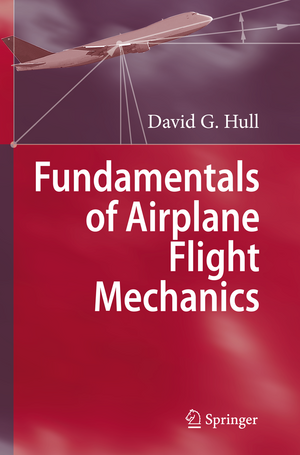Fundamentals of Airplane Flight Mechanics
Autor David G. Hullen Limba Engleză Hardback – 5 feb 2007
| Toate formatele și edițiile | Preț | Express |
|---|---|---|
| Paperback (1) | 528.30 lei 6-8 săpt. | |
| Springer Berlin, Heidelberg – 14 oct 2010 | 528.30 lei 6-8 săpt. | |
| Hardback (1) | 731.18 lei 6-8 săpt. | |
| Springer Berlin, Heidelberg – 5 feb 2007 | 731.18 lei 6-8 săpt. |
Preț: 731.18 lei
Preț vechi: 860.21 lei
-15% Nou
Puncte Express: 1097
Preț estimativ în valută:
139.93€ • 145.55$ • 115.52£
139.93€ • 145.55$ • 115.52£
Carte tipărită la comandă
Livrare economică 14-28 aprilie
Preluare comenzi: 021 569.72.76
Specificații
ISBN-13: 9783540465713
ISBN-10: 3540465715
Pagini: 312
Ilustrații: XIII, 298 p.
Dimensiuni: 155 x 235 x 25 mm
Greutate: 1.37 kg
Ediția:2007
Editura: Springer Berlin, Heidelberg
Colecția Springer
Locul publicării:Berlin, Heidelberg, Germany
ISBN-10: 3540465715
Pagini: 312
Ilustrații: XIII, 298 p.
Dimensiuni: 155 x 235 x 25 mm
Greutate: 1.37 kg
Ediția:2007
Editura: Springer Berlin, Heidelberg
Colecția Springer
Locul publicării:Berlin, Heidelberg, Germany
Public țintă
GraduateCuprins
to Airplane Flight Mechanics.- 3DOF Equations of Motion.- Atmosphere, Aerodynamics, and Propulsion.- Cruise and Climb of an Arbitrary Airplane.- Cruise and Climb of an Ideal Subsonic Airplane.- Take-off and Landing.- PS and Turns.- 6DOF Model: Wind Axes.- Static Stability and Control.- 6DOF Model: Body Axes.- Dynamic Stability and Control.
Recenzii
From the reviews:
"The text under review addresses performance, stability, and control (static and dynamic) characteristics of aircraft from the viewpoint, according to the author, of a one semester, junior-level course on these topics. … It is readable, at an appropriate level for undergraduates … . It is also a good choice to help a more experienced person to come up to speed on basic flight mechanics. I certainly recommend it for these situations." (Keith Koenig, SIAM Review, Vol. 49 (4), 2007)
"There are two basic problems in airplane mechanics: (1) given an airplane, what are its performance, stability and control characteristics? and (2) given performance, stability and control characteristics, what is the airplane? The book is concerned with the first problem, but its organization is motivated by the structure of the second problem. … The book is not only a very good educational tool, but also a competent research exposition monograph, and it is recommended to students and researchers in flight mechanics." (Adrian Carabineanu, Zentralblatt MATH, Vol. 1126 (3), 2008)
"The text under review addresses performance, stability, and control (static and dynamic) characteristics of aircraft from the viewpoint, according to the author, of a one semester, junior-level course on these topics. … It is readable, at an appropriate level for undergraduates … . It is also a good choice to help a more experienced person to come up to speed on basic flight mechanics. I certainly recommend it for these situations." (Keith Koenig, SIAM Review, Vol. 49 (4), 2007)
"There are two basic problems in airplane mechanics: (1) given an airplane, what are its performance, stability and control characteristics? and (2) given performance, stability and control characteristics, what is the airplane? The book is concerned with the first problem, but its organization is motivated by the structure of the second problem. … The book is not only a very good educational tool, but also a competent research exposition monograph, and it is recommended to students and researchers in flight mechanics." (Adrian Carabineanu, Zentralblatt MATH, Vol. 1126 (3), 2008)
Textul de pe ultima copertă
Airplane flight mechanics is the application of Newton's laws to the study of airplane trajectories (performance), stability, and aerodynamic control. This text is limited to flight in a vertical plane and is divided into two parts. The first part, trajectory analysis, is concerned primarily with the derivation of analytical solutions of trajectory problems associated with the sizing of commercial jets, that is, take-off, climb, cruise, descent, and landing, including trajectory optimization. The second part, stability and control, is further classified as static or dynamic. On each iteration of airplane sizing, the center of gravity is placed so that the airplane is statically stable. Dynamic stability and control is included to study the response of an airplane to control and gust inputs, which is needed for the design of automatic flight control systems. Algorithms are presented for estimating lift, drag, pitching moment, and stability derivatives.
Flight mechanics is a discipline. As such, it has equations of motion, acceptable approximations, and solution techniques for the approximate equations of motion. Once an analytical solution has been obtained, numbers are calculated in order to compare the answer with the assumptions used to derive it and to acquaint students with the sizes of the numbers. A subsonic business jet is used for these calculations.
Flight mechanics is a discipline. As such, it has equations of motion, acceptable approximations, and solution techniques for the approximate equations of motion. Once an analytical solution has been obtained, numbers are calculated in order to compare the answer with the assumptions used to derive it and to acquaint students with the sizes of the numbers. A subsonic business jet is used for these calculations.
Caracteristici
A new avenue to flight dynamics through equations of motion Focus put on the important issues: trajectory analysis and stability and control Complete algorithms are presented for computing aerodynamics Request lecturer material: sn.pub/lecturer-material









